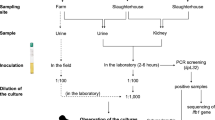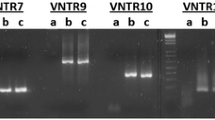Abstract
Purpose of Review
Leptospirosis is a zoonotic disease caused by pathogenic spirochetes of the genus Leptospira. In Central America, Leptospira is endemic, and almost all countries experience frequent outbreaks. Diagnosis of leptospirosis is primarily based on serology. More technologically advanced methods, such as polymerase chain reaction (PCR), are used in only a few laboratories, although it can identify genes specific to pathogenic species. New techniques, such as isothermal reactions and molecular ty** could also contribute to disease surveillance in humans, animals, and the environment.
Recent Findings
Advanced techniques, including molecular characterization methods, have been used only rarely up until now. In Nicaragua, we have used phenotypic analysis to characterize pathogenic Leptospira species and multiple locus sequence ty** (MLST) to facilitate the identification of a completely new serovar in Costa Rica.
Summary
Improved technology and expertise for molecular ty** of Leptospira are needed in order to improve surveillance and provide the basis for epidemiologic studies. Current MLST characterization schemes include representative strains known to be circulating in Central America, and a more widespread implementation of this technique could enrich information about the epidemiology of Leptospira and enable identification of novel strains emerging in the region.

Similar content being viewed by others
References
Papers of particular interest, published recently, have been highlighted as: • Of importance
Schneider MC, Nájera P, Aldighieri S, et al. Leptospirosis outbreaks in Nicaragua: identifying critical areas and exploring drivers for evidence-based planning. Int J Environ Res Public Health. 2012;9:3883–910. This is a complete epidemiological study, carried out in Nicaragua with data obtained from the health system and other institutions of the country.
Naranjo M, Suárez M, Fernández C, Amador N, González M, Batista N, et al. Study of a leptospirosis outbreak in Honduras following hurricane Mitch and prophylactic protection of the vax-SPIRAL® vaccine. MEDICC Rev. 2008;10:38–42.
Centers for Disease Control and Prevention (CDC). Outbreak of leptospirosis among white-water rafters--Costa Rica, 1996. MMWR Morb Mortal Wkly Rep. 1997;46:577–9.
Zaki SR, Shieh WJ. Leptospirosis associated with outbreak of acute febrile illness and pulmonary haemorrhage, Nicaragua, 1995. The Epidemic Working Group at Ministry of Health in Nicaragua. Lancet Lond Engl. 1996;347:535–6.
Pappas G, Papadimitriou P, Siozopoulou V, Christou L, Akritidis N. The globalization of leptospirosis: worldwide incidence trends. Int J Infect Dis. 2008;12:351–7.
Trevejo RT, Rigau-Pérez JG, Ashford DA, et al. Epidemic leptospirosis associated with pulmonary hemorrhage—Nicaragua, 1995. J Infect Dis. 1998;178:1457–63. This is the first study to describe pulmonary hemorrhagic fever in the American continent.
Ashford DA, Kaiser RM, Spiegel RA, Perkins BA, Weyant RS, Bragg SL, et al. Asymptomatic infection and risk factors for leptospirosis in Nicaragua. Am J Trop Med Hyg. 2000;63:249–54.
Costa F, Martinez-Silveira MS, Hagan JE, Hartskeerl RA, dos Reis MG, Ko AI. Surveillance for leptospirosis in the Americas, 1996–2005: a review of data from ministries of health. Rev Panam Salud Publica Pan Am J Public Health. 2012;32:169–77.
Levett PN. Leptospirosis. Clin Microbiol Rev. 2001;14:296–326. A review by one of the most prestigious investigators on the subject of leptospirosis describes the diagnosis and classification of leptopires.
Rosario LA, Arencibia DF, Batista N, Jirón W, Suárez YE, Infante JF. Caracterización de aislamientos clínicos de Leptospira por métodos fenotípicos y moleculares en la República de Nicaragua. VacciMonitor. 2012;21:6–12.
Smythe L, Adler B, Hartskeerl RA, Galloway RL, Turenne CY, Levett PN, et al. Classification of Leptospira genomospecies 1, 3, 4 and 5 as Leptospira alstonii sp. nov., Leptospira vanthielii sp. nov., Leptospira terpstrae sp. nov. and Leptospira yanagawae sp. nov., respectively. Int J Syst Evol Microbiol. 2013;63:1859–62.
Brenner DJ, Kaufmann AF, Sulzer KR, Steigerwalt AG, Rogers FC, Weyant RS. Further determination of DNA relatedness between serogroups and serovars in the family Leptospiraceae with a proposal for Leptospira alexanderi sp. nov. and four new Leptospira genomospecies. Int J Syst Bacteriol. 1999;49(Pt 2):839–58.
Levett PN. Usefulness of serologic analysis as a predictor of the infecting serovar in patients with severe leptospirosis. Clin Infect Dis. 2003;36:447–52.
Ortiz E (2011) Elaboración del Plan de Trabajo Interinstitucional para el abordaje de la Leptospirosis. http://www.paho.org/nic/index.php?option=com_content&view=article&id=335%3Aelaboracin-del-plan-de-trabajo-interinstitucional-para-el-abordaje-de-la-leptospirosis&catid=735%3Aarchivo-de-noticias&Itemid=244. Accessed 1 Dec 2016
Rodríguez-Moreno V, Romero-Zúñiga JJ. Definiciones operativas para la prevención y control de la leptospirosis en Costa Rica Operative Definitions for Prevention and Control of Leptospirosis in Costa Rica. Acta Méd Costarric. 2010;52:232–9.
Agampodi SB, Matthias MA, Moreno AC, Vinetz JM. Utility of quantitative polymerase chain reaction in leptospirosis diagnosis: association of level of leptospiremia and clinical manifestations in Sri Lanka. Clin Infect Dis Off Publ Infect Dis Soc Am. 2012;54:1249–55.
Levett PN, Morey RE, Galloway RL, Turner DE, Steigerwalt AG, Mayer LW. Detection of pathogenic leptospires by real-time quantitative PCR. J Med Microbiol. 2005;54:45–9.
Merien F, Portnoi D, Bourhy P, Charavay F, Berlioz-Arthaud A, Baranton G. A rapid and quantitative method for the detection of Leptospira species in human leptospirosis. FEMS Microbiol Lett. 2005;249:139–47.
Ahmed A, Engelberts MFM, Boer KR, Ahmed N, Hartskeerl RA. Development and validation of a real-time PCR for detection of pathogenic Leptospira species in clinical materials. PLoS ONE. 2009. doi:10.1371/journal.pone.0007093.
Boonsilp S, Thaipadungpanit J, Amornchai P, Wuthiekanun V, Chierakul W, Limmathurotsakul D, et al. Molecular detection and speciation of pathogenic Leptospira spp. in blood from patients with culture-negative leptospirosis. BMC Infect Dis. 2011;11:338.
Bourhy P, Bremont S, Zinini F, Giry C, Picardeau M. Comparison of real-time PCR assays for detection of pathogenic Leptospira spp. in blood and identification of variations in target sequences. J Clin Microbiol. 2011;49:2154–60.
Rawlins J, Portanova A, Zuckerman I, Loftis A, Ceccato P, Willingham AL, et al. Molecular detection of leptospiral DNA in environmental water on St. Kitts. Int J Environ Res Public Health. 2014;11:7953–60.
Xu C, Loftis A, Ahluwalia SK, Gao D, Verma A, Wang C, et al. Diagnosis of canine leptospirosis by a highly sensitive FRET-PCR targeting the lig genes. PLoS ONE. 2014. doi:10.1371/journal.pone.0089507.
Suwancharoe D, Sittiwicheanwong B, Wiratsudakul A. Evaluation of loop-mediated isothermal amplification method (LAMP) for pathogenic Leptospira spp. detection with leptospires isolation and real-time PCR. J Vet Med Sci. 2016;78:1299–302.
Chen H-W, Weissenberger G, Atkins E, Chao C-C, Suputtamongkol Y, Ching W-M. Highly sensitive loop-mediated isothermal amplification for the detection of Leptospira. Int J Bacteriol. 2015;2015:147173.
Notomi T, Okayama H, Masubuchi H, Yonekawa T, Watanabe K, Amino N, et al. Loop-mediated isothermal amplification of DNA. Nucleic Acids Res. 2000;28:E63.
Mori Y, Notomi T. Loop-mediated isothermal amplification (LAMP): a rapid, accurate, and cost-effective diagnostic method for infectious diseases. J Infect Chemother Off J Jpn Soc Chemother. 2009;15:62–9.
Mori Y, Nagamine K, Tomita N, Notomi T. Detection of loop-mediated isothermal amplification reaction by turbidity derived from magnesium pyrophosphate formation. Biochem Biophys Res Commun. 2001;289:150–4.
Mori Y, Kitao M, Tomita N, Notomi T. Real-time turbidimetry of LAMP reaction for quantifying template DNA. J Biochem Biophys Methods. 2004;59:145–57.
Almasi MA, Hosseyni-Dehabadi SM, Aghapour-ojaghkandi M. Comparison and evaluation of three diagnostic methods for detection of beet curly top virus in sugar beet using different visualizing systems. Appl Biochem Biotechnol. 2014;173:1836–48.
Inoshima Y, Takasu M, Ishiguro N. Establishment of an on-site diagnostic procedure for detection of orf virus from oral lesions of Japanese serows (Capricornis crispus) by loop-mediated isothermal amplification. J Vet Med Sci. 2016. doi:10.1292/jvms.16-0268.
Lin X, Chen Y, Lu Y, Yan J, Yan J. Application of a loop-mediated isothermal amplification method for the detection of pathogenic Leptospira. Diagn Microbiol Infect Dis. 2009;63:237–42.
Wastling SL, Picozzi K, Kakembo ASL, Welburn SC. LAMP for human African trypanosomiasis: a comparative study of detection formats. PLoS Negl Trop Dis. 2010;4:e865.
Almasi MA, Erfan Manesh M, Jafary H, Dehabadi SMH. Visual detection of Potato Leafroll virus by loop-mediated isothermal amplification of DNA with the GeneFinderTM dye. J Virol Methods. 2013;192:51–4.
Zhang X, Lowe SB, Gooding JJ. Brief review of monitoring methods for loop-mediated isothermal amplification (LAMP). Biosens Bioelectron. 2014;61:491–9.
Zuerner RL. Nucleotide sequence analysis of IS1533 from Leptospira borgpetersenii: identification and expression of two IS-encoded proteins. Plasmid. 1994;31:1–11.
Zuerner RL, Bolin CA. Differentiation of Leptospira interrogans isolates by IS1500 hybridization and PCR assays. J Clin Microbiol. 1997;35:2612–7.
Zuerner RL, Huang WM. Analysis of a Leptospira interrogans locus containing DNA replication genes and a new IS, IS1502. FEMS Microbiol Lett. 2002;215:175–82.
Pavan ME, Brihuega B, Pettinari MJ, Cairó F. Multiple-locus variable-number tandem repeat analysis of reference strains used for the diagnosis of leptospirosis in Argentina. Rev Argent Microbiol. 2011;43:251–5.
Ahmed A, Thaipadungpanit J, Boonsilp S, et al. Comparison of two multilocus sequence based genoty** schemes for Leptospira species. PLoS Negl Trop Dis. 2011;5:e1374.
Ahmed N, Devi SM, Mde Valverde L, Vijayachari P, Machang’u RS, Ellis WA, et al. Multilocus sequence ty** method for identification and genotypic classification of pathogenic Leptospira species. Ann Clin Microbiol Antimicrob. 2006;5:28.
Boonsilp S, Thaipadungpanit J, Amornchai P, et al. A single multilocus sequence ty** (MLST) scheme for seven pathogenic Leptospira species. PLoS Negl Trop Dis. 2013;7:e1954.
Varni V, Ruybal P, Lauthier JJ, Tomasini N, Brihuega B, Koval A, et al. Reassessment of MLST schemes for Leptospira spp. ty** worldwide. Infect Genet Evol. 2014;22:216–22.
Valverde Mde L, Ramírez JM, de Oca LG M, Goris MGA, Ahmed N, Hartskeerl RA. Arenal, a new Leptospira serovar of serogroup Javanica, isolated from a patient in Costa Rica. Infect Genet Evol J Mol Epidemiol Evol Genet Infect Dis. 2008;8:529–33.
Thaipadungpanit J, Wuthiekanun V, Chierakul W, et al. A dominant clone of Leptospira interrogans associated with an outbreak of human leptospirosis in Thailand. PLoS Negl Trop Dis. 2007. doi:10.1371/journal.pntd.0000056.
Agampodi SB, Moreno AC, Vinetz JM, Matthias MA. Utility and limitations of direct multi-locus sequence ty** on qPCR-positive blood to determine infecting Leptospira strain. Am J Trop Med Hyg. 2013;88:184–5.
Perez J, Goarant C. Rapid Leptospira identification by direct sequencing of the diagnostic PCR products in New Caledonia. BMC Microbiol. 2010;10:325.
Acknowledgements
We would like to thank Rodion Gorchakov in the Laboratory for Zoonotic and Vectorborne Diseases at Baylor College of Medicine for lending his expertise, when needed, on sequencing methods of Leptospira employed in his laboratory and for his encouragement of our ongoing work.
Author information
Authors and Affiliations
Corresponding author
Ethics declarations
Conflict of Interest
Byron Flores Somarriba, Jessica Sheleby-Elías, Rebecca S.B. Fischer, William Jirón, and Christiane Duttmann declare that they have no conflicts of interest.
Human and Animal Rights and Informed Consent
This article does not contain any studies with human or animal subjects performed by any of the authors.
Additional information
This article is part of the Topical Collection on Leptospirosis in Mesoamerica
Rights and permissions
About this article
Cite this article
Flores Somarriba, B., Sheleby-Elías, J., Fischer, R.S.B. et al. Leptospirosis in Central America: Techniques for Diagnosis and Molecular Characterization. Curr Trop Med Rep 4, 70–76 (2017). https://doi.org/10.1007/s40475-017-0106-6
Published:
Issue Date:
DOI: https://doi.org/10.1007/s40475-017-0106-6




